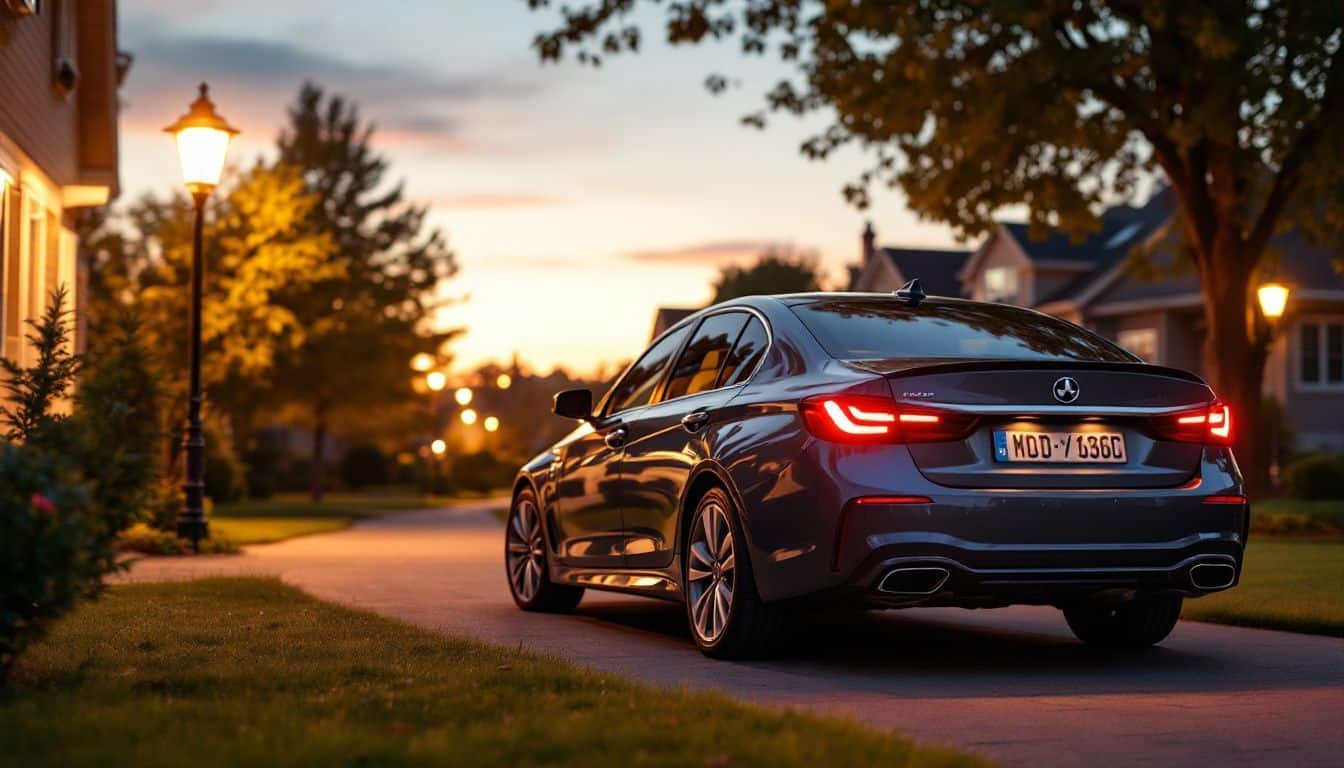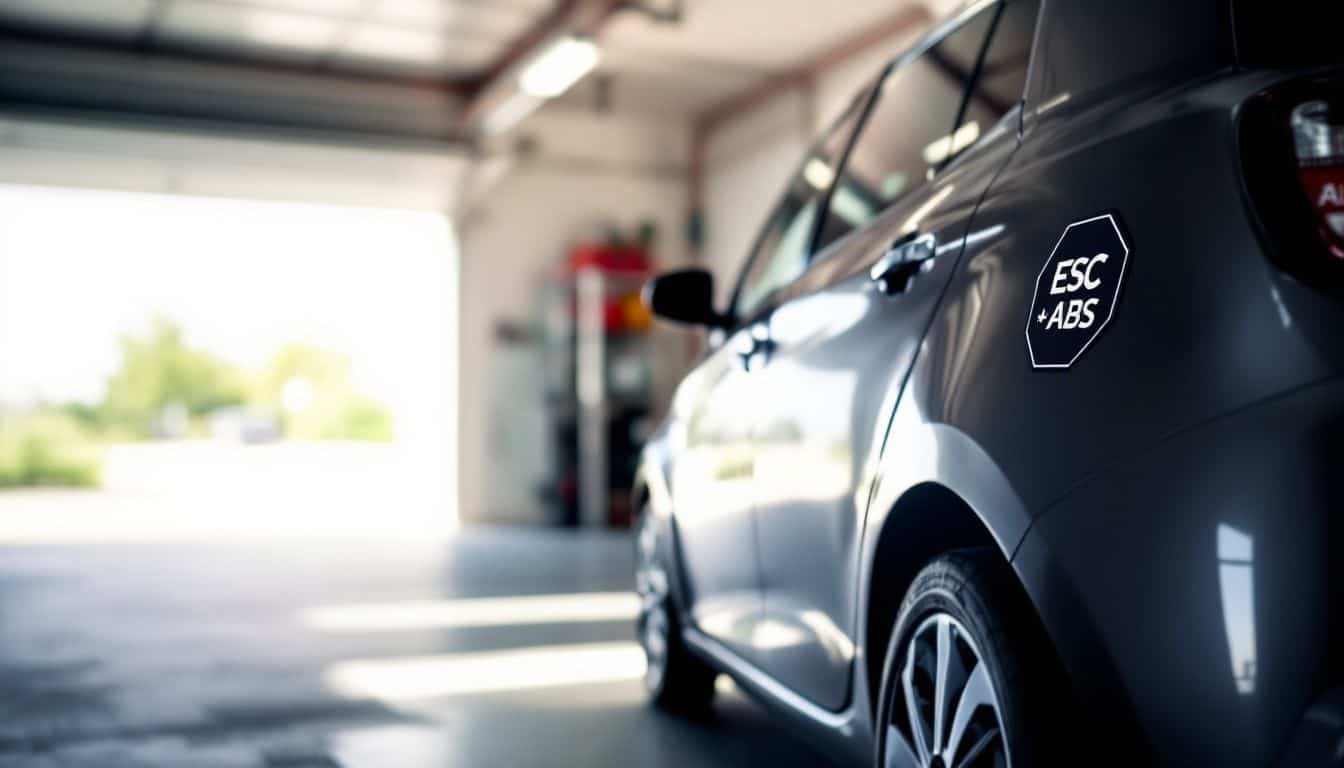Car insurance for young drivers is expensive. Eight teens die daily in car crashes. This article helps you find the best car for insurance young drivers.
Learn how to save money.
Key Takeaways
Young drivers can save money on car insurance by choosing the right car. Safe and affordable options include the Honda Civic, Toyota Corolla, and Nissan Sentra. These cars have safety features that can lower insurance costs.
Safety features like anti-lock brakes, electronic stability control, and advanced driver-assistance systems (ADAS) can lower insurance premiums. ADAS features, such as lane departure warnings and automatic emergency braking, can reduce accidents.
Car insurance costs are affected by many things. Age, location, and driving history all play a role. Vehicle type also matters. Sports cars cost more to insure than sedans. A clean driving record will save you money.
Staying on a parent’s insurance policy can save young drivers money. An 18-year-old on their own policy pays about $6,517 yearly. Adding a teen to a parent’s policy costs about $4,365 yearly.
Higher deductibles, lower monthly premiums. Increasing your deductible to $1,000 can save you $517 to $919 each year. Compare rates from different insurance companies like Progressive, Geico, State Farm, USAA, Auto-Owners, Erie, American Family, and Nationwide.
Table of Contents
Understanding Insurance Costs for Young Drivers

Insurance costs can feel confusing for new drivers. Many factors—like your car, age, and location—affect your rates, so research tools and resources can help you understand your insurance premium.
Factors That Influence Insurance Rates

Your age matters. Younger drivers, like young women, often pay more. Location affects rates. Living in a city costs more than rural areas. Marital status plays a role. Married women sometimes get lower rates.
Your job can influence insurance premiums. Credit history is a factor. A good credit score helps. Driving history is key. A clean record saves you money. Get car insurance quotes to compare pricing from insurance companies.
Average full coverage costs $5,296 yearly for young drivers. Minimum coverage averages $2,154. For minimum coverage, young adults pay between $806 and $1,373 each year.
Vehicle type impacts costs. Sports cars are pricier to insure than compact cars or sedans like a Honda Civic or Toyota Corolla. Safety features like anti-lock brakes, stability control, and forward collision warning (FCW) can lower your premium.
Older cars might lack these features, affecting your insurance costs.
Drive safely. Save money.
Average Insurance Rates by Age and Vehicle Type
 Insurance costs change with age and vehicle type. Eighteen-year-old women pay about $6,353 yearly for full coverage. Twenty- to 25-year-old women pay between $2,929 and $4,818. Around age 70, rates may rise. Full coverage averages $2,388 yearly, minimum coverage $664. Vehicle choice impacts these costs.
Insurance costs change with age and vehicle type. Eighteen-year-old women pay about $6,353 yearly for full coverage. Twenty- to 25-year-old women pay between $2,929 and $4,818. Around age 70, rates may rise. Full coverage averages $2,388 yearly, minimum coverage $664. Vehicle choice impacts these costs.
| Age | Average Annual Premium (Full Coverage) |
|---|---|
| 18 (Female) | $6,353 |
| 20-25 | $2,929 – $4,818 |
| 70+ | May increase |
| All Ages | $2,388 |
Let’s explore economical vehicles like the Honda Civic, Toyota Corolla, and Nissan Sentra.
Top Economical Cars for Young Drivers

Saving money on car insurance is a top priority for young drivers. Find out which cars—like sedans—offer great fuel economy and lower insurance costs.
Honda Civic

The 2025 Honda Civic costs $25,345. It gets 36 MPG combined. The IIHS rates it a Top Safety Pick++. Good for new teen drivers. Consider a used Civic for under $10,000. Civics offer great fuel economy and safety features—like Honda Sensing—which can lower insurance premiums.
Electronic Stability Control (ESC) and antilock brakes are standard. Look for driver-assistance technology like lane-keeping assist and adaptive cruise control in some models. These features can help young drivers stay safe on the road, potentially lowering insurance costs.
Safety isn’t expensive, it’s priceless.
Toyota Corolla

Like the Honda Civic, the Toyota Corolla offers great value and safety. The 2024 model starts at $23,185. It gets 35 MPG combined. The Insurance Institute for Highway Safety (IIHS) named it a Top Safety Pick.
The 2025 Corolla starts a bit lower, at $22,175. It gets better gas mileage, too—32 MPG in the city and 41 MPG on the highway. Toyota Safety Sense and driver-assistance features like automatic emergency braking and lane departure warning make it a safe, affordable choice for new drivers.
These features often bring down auto insurance premiums. Consider these compact cars for financial protection and highway safety.
Nissan Sentra

The 2024 Nissan Sentra costs $22,320. It gets 30 MPG in the city. It gets 40 MPG on the highway. Young drivers can save 40% on insurance. The Sentra has Safety Shield 360. These are driver-assist features.
They improve traffic safety. Consider collision avoidance and lane-keep assist. These features can lower insurance premiums. Good student discounts also help. Check with your insurance company, like State Farm or Geico, for more details.
Compare rates from different auto insurers. Think about staying on a parent’s policy. A clean driving record keeps rates low. Speeding tickets raise rates. Safe driving habits matter.
Now, let’s look at how different vehicle types affect insurance costs.
Key Safety Features in Cars for Young Drivers

Safety features can save lives—and money. Explore Electronic Stability Control (ESC) and Anti-lock Braking Systems (ABS) for better control and shorter stopping distances.
The Importance of Advanced Safety Features
Advanced driver-assistance systems (ADAS) like lane departure warnings, blind-spot monitors, and pre-collision systems can significantly reduce vehicle crashes. The ADAS market is booming, projected to reach $83 billion by 2030, up from $27 billion in 2023.
Consider these features. They can lower insurance premiums. Vehicles with ADAS have 27% fewer bodily injury claims. Blind-spot monitoring alone cuts crash involvement by 14%. Features like traction control, collision-avoidance, and driver assists make cars safer for young drivers, especially in compact SUVs like the Honda CR-V, Toyota RAV4, or Mazda CX-5.
Yes, repairs cost more with ADAS—about $3,000 more for minor incidents. But, the safety benefits are substantial. Choose cars with LED headlights, turn signals, and taillights for better visibility.
Better to arrive late than never.
Look for driver assistance technology. These features can help prevent motor vehicle crashes. Think about a Honda Civic, Toyota Corolla, or Nissan Sentra. These are good choices for young drivers.
They often have lower insurance rates. Consider fuel-efficient cars like the Toyota Corolla Hybrid or Toyota Prius. Adding safety features can save you money on insurance. Higher deductibles also lower premiums.
Check with the National Highway Traffic Safety Administration (NHTSA) and the Better Business Bureau (BBB) for safety ratings and insurance provider reviews. A clean driving record is crucial.
Traffic violations increase insurance costs. Consider staying on a parent’s policy. Compare rates from different insurance providers like those offered by the American Automobile Association (AAA) and those recommended by the National Association of Insurance Commissioners.
Recommended Safety Features for Lower Insurance Premiums
Safe vehicles often mean lower insurance costs. These features can make your car—and you—safer.
- Anti-lock Brakes (ABS):ABS helps you steer during hard braking. They prevent skids and shorten stopping distances. This matters in emergencies.
- Adaptive Cruise Control: This system keeps a safe distance from other cars. It adjusts your speed automatically. This reduces rear-end collisions.
- Lane Keep Assist/Lane Departure Warning: These features help you stay in your lane. Lane departure warnings alert you if you drift. Lane keep assist gently steers you back. Both reduce single-vehicle accidents.
- Collision Warning and Blind-Spot Detection: Collision warning systems alert you to potential frontal crashes. Blind-spot detection helps you see cars in your blind spots. Both can prevent accidents. You might get discounts for these. Knowing what to do after a car accident is also important.
Comparing Vehicle Types and Their Insurance Impacts

Smaller cars, like sedans and hatchbacks, often mean lower premiums. SUVs and sports cars usually cost more to insure—find out why.
Differences Between Sedans, SUVs, and Sports Cars
Choosing the right car type impacts insurance costs. Consider these factors when picking your first car.
- Sedans: These cars, like the Honda Civic, Toyota Corolla, or Mazda Mazda3, often have lower insurance rates. They typically have lower claim probabilities and severities. Small vehicles are generally cheaper to insure.
- SUVs:SUVs, like the Subaru Crosstrek, Forester, or Outback, can have higher insurance premiums than sedans, despite lower claim severity. New cars and SUVs have higher claim probabilities. The Subaru Outback, Crosstrek, and Forester are the cheapest SUVs to insure.
- Sports Cars:These cars often have the highest insurance rates. Their higher performance and likelihood for speeding tickets increase costs.
How the Age of a Car Influences Insurance Rates
Car age matters for insurance. Older cars often cost less to insure. Their value is lower. Repair costs are less, too. New cars cost more. Liability coverage adds to premiums for new drivers.
Older cars, like a used Honda Accord or Toyota Camry, can mean lower rates. This is especially true compared to a new electric vehicle or a Kia Sportage. Safety features, like lane centering or fog lights, can also impact rates.
Consider these factors. Think about your budget.
A penny saved is a penny earned. – Benjamin Franklin
Selecting the right vehicle is key. Safety features can help lower costs. Higher deductibles can also save money.
Strategies to Reduce Car Insurance Premiums for Young Drivers

Want lower insurance costs? Smart choices, like a used Honda Fit and safe driving, can make a big difference. Find out how factors like deductibles and discounts impact your premium—and your wallet.
Selecting the Appropriate Vehicle
Car choice impacts insurance costs. Older sedans are often cheaper to insure. Safer cars, like a used Toyota Corolla or Honda Civic, with good crash-test ratings, often mean lower premiums.
Consider theft rates, too. A Kia Soul is less likely to be stolen than a Toyota Avalon. Features like turn-signal indicators, Apple Carplay, and continuously variable transmission can also influence rates.
Choosing the right car can save you 40%…or more. Now, let’s enhance your car with safety features.
Enhancing Vehicles with Safety Features
Safety features save money. Activate ADAS features like lane departure warnings and automatic emergency braking. These features lower your insurance premiums. Consider backup cameras and blind spot monitoring.
They make driving safer. Safer driving means fewer accidents. Fewer accidents mean lower insurance costs. Choosing higher deductibles also reduces premiums. Progressive, Geico, Auto-Owners, State Farm, and Nationwide offer good coverage options.
Now, let’s look at choosing insurance providers….
Choosing Higher Deductibles
Upgrading your Toyota’s safety features—like adding lane departure warnings—can lower your premiums. Consider your deductible, too. A higher deductible means you pay more out-of-pocket if you have an accident.
But, it also lowers your monthly premium. Increasing your deductible to $1,000 can save you $517 to $919 each year. Think of it as a balancing act. A lower premium means more money in your pocket now.
A higher deductible means more money out-of-pocket later if something happens. Choose what works for your budget. You can also save 5% to 10% by paying your annual premium upfront.
Choosing Insurance Providers for Young Drivers

Research insurance companies like Progressive, Geico, and State Farm—find the best rates and coverage… Want to learn more? Read on.
Comparing Leading Insurance Providers
Choosing the right car insurance is important. For military families, USAA offers the lowest rates for liability-only coverage. Auto-Owner’s Insurance has affordable premiums and happy customers. Progressive offers accident forgiveness. They also give discounts for distant students and good grades. Erie, USAA, American Family, and Nationwide are good, cheap choices for teens.
| Company | Benefits |
|---|---|
| USAA | Cheapest liability-only for military families. |
| Auto-Owners Insurance | Affordable premiums, high customer satisfaction. |
| Progressive | Accident forgiveness, discounts for students. |
| Erie | Cheap option for teens. |
| American Family | Cheap option for teens. |
| Nationwide | Cheap option for teens. |
Advantages of Remaining on a Parent’s Policy
Staying on a parent’s insurance policy saves money. An 18-year-old pays about $6,517 for their own policy. Adding a teen to a parent’s policy costs around $4,365. This saves hundreds.
Parents with homeowners insurance and multiple cars often get discounts. These discounts lower the premium. Teens gain driving experience. A clean driving record helps lower future insurance costs.
Safe driving habits, like avoiding distracted driving, matter. Look for insurers like Quadrant Information Services. They offer competitive rates.
The Influence of Driving Records on Insurance Costs

Safe driving saves cash—want lower premiums? Read on.
How a Clean Driving Record Can Lower Rates
A clean driving record saves you money. Good drivers pay less for insurance. You can save $289 each year. Avoid tickets and accidents. This keeps your insurance low. Consider a used car like a Kia Seltos or Mazda CX-5.
A policyholder with a clean record gets better rates. This is true for all vehicle types—sedans, SUVs—like the Chevrolet Equinox or Hyundai Kona—and sports cars. It also applies to Acura or other luxury makes.
Insurance companies reward safe drivers.
Effects of Traffic Violations on Insurance Premiums
Safe drivers pay less. Traffic tickets raise rates. Minor infractions mean small increases. Think parking tickets. Major violations mean big jumps. A DUI adds many points in California.
Safe driving keeps your insurance affordable. Your record matters. Points impact premiums. Safe driving saves money. Even small incidents matter. Consider a moderate overlap fender bender.
This could affect your insured Mazda CX-5’s rate. Drive safely. Avoid points. Keep costs low.
People Also Ask
Is the Mazda CX-5 good for young drivers’ insurance?
Yes, the Mazda CX-5 is often cheaper to insure for young drivers. They could save money.
Why is the Mazda CX-5 cheaper to insure for young people?
Insurance companies see the Mazda CX-5 as safe. It has good safety features. This helps lower costs for new drivers.
How much can a young driver save on insurance with a Mazda CX-5?
Young drivers could save up to 40% on insurance with a Mazda CX-5, but, it depends on many things. Their age, where they live—lots of things.
Are there other cars like the Mazda CX-5 for cheap insurance?
Yes, there are other vehicles with similar insurance savings, but the CX-5 is a good pick. It’s safe, reliable—a solid choice.
References
https://www.bankrate.com/insurance/car/young-drivers/
https://www.bankrate.com/insurance/car/auto-insurance-rates-by-age/
https://www.civic11forum.com/threads/best-honda-for-new-teen-driver.4838/ (2023-04-25)
https://www.thezebra.com/resources/driving/best-cars-for-teens/ (2024-04-24)
https://www.toyota.com/cars-for-teenagers/
https://www.forbes.com/advisor/car-insurance/vehicle-safety-features-accidents/
https://clovered.com/safety-features-that-lower-car-insurance/
https://onlinelibrary.wiley.com/doi/10.1111/rmir.12163
https://www.nerdwallet.com/article/insurance/cars-cheapest-auto-insurance-rates (2024-09-18)
https://wallethub.com/edu/ci/factors-that-affect-car-insurance-rates/69302
https://www.bankrate.com/insurance/car/teen-discounts/ (2023-10-13)
https://www.thezebra.com/resources/car-insurance/teen-driver-insurance-tips/
https://www.cnbc.com/select/best-car-insurance-young-adults/
https://www.fool.com/the-ascent/research/auto-insurance-costs-driving-record/
https://www.atwoodins.com/2024/05/28/the-impact-of-traffic-violations-on-auto-insurance-premiums-in-california/ (2024-05-28)
